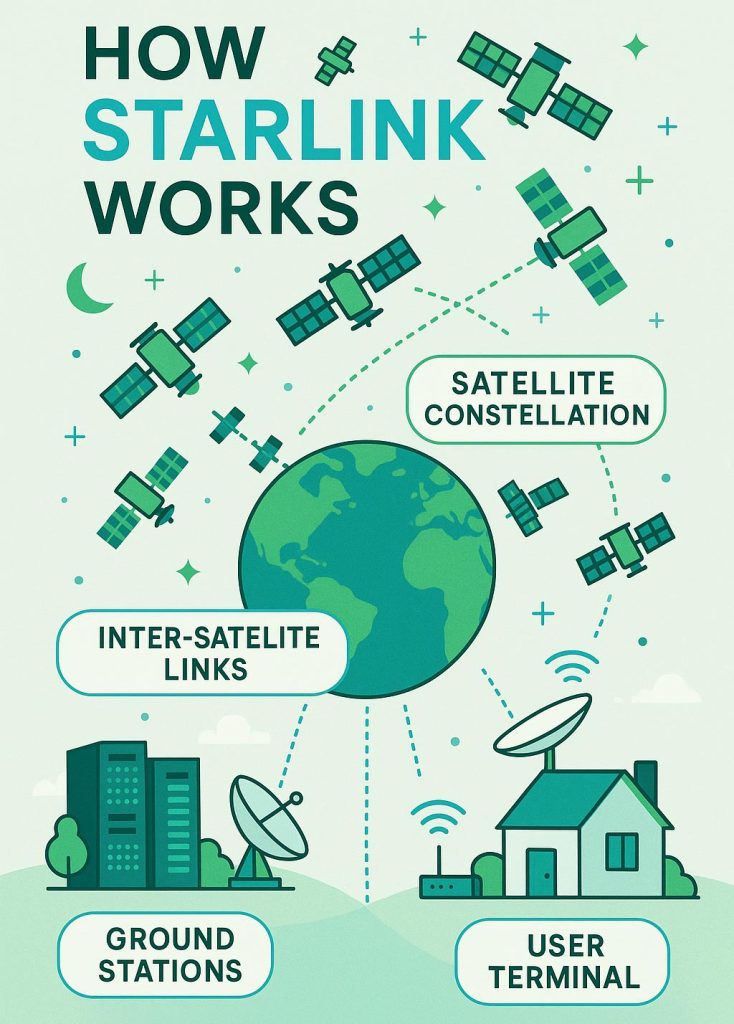- Starlink delivers high-speed internet almost anywhere, making it ideal for rural homes or places with limited connectivity options.
- Most Starlink plans include unlimited data, so you can stream, game, and work without worrying about usage limits.
- The setup is simple, just plug in the dish, point it at the sky, and you’re online within minutes, no technician required.
- Starlink is more expensive than many cable or fiber providers and doesn’t offer discounts for students, seniors, or low-income household.
- Calculate Your Moving Costs
- Compare Moving Companies
- Get Multiple Quotes
- Move with Confidence
Meet Starlink
Starlink isn’t your grandpa’s satellite internet. Traditional providers like Hughesnet use satellites 22,000 miles up, causing laggy video calls and endless buffering. Starlink’s satellites? Just 340 miles high, slashing latency to 25-60ms, good enough for gaming and Zoom meetings! They’re part of SpaceX, which means rocket science literally powers your WiFi.
Since its beta launch in 2020, it has rapidly grown to over 6 million users across more than 140 countries as of June 2025. Powered by a constellation of over 7,600 low Earth orbit satellites, Starlink delivers high-speed, low-latency internet even in the most remote areas. Backed by Elon Musk’s vision, it’s transforming global internet access from dense cities to off-grid regions. If you crave innovation and hate dead zones, Starlink’s your jam.
Plans Offered by Starlink
Plans and Pricing
| Plan Name | Price | Download Speeds | Connection Type | |
|---|---|---|---|---|
| Residential Lite | $59 /month | Up to 200 Mbps | Satellite | Check Availability |
| Roam - 50 GB | $50 /month | Up to 260 Mbps | Satellite | Check Availability |
| Roam - Unlimiited | $165 /month | Up to 260 Mbps | Satellite | Check Availability |
| Residential | $85 /month | Up to 350 Mbps | Satellite | Check Availability |
*pricing and speeds may vary by location.
Whether you’re Netflix-binging at home or sailing the Atlantic, Starlink has a plan. Prices include unlimited data (no caps!), but speeds vary. Here’s the scoop:
| Plan | Best For | Key Perks |
|---|---|---|
| Residential | Families, remote work | Reliable home internet |
| Residential Lite | Light users, budgets | Same coverage, slower peak speeds |
| Roam (50GB) | Road trips, RVs | Use anywhere, pause anytime |
| Roam Unlimited | Nomads, digital sailors | No data limits, in-motion use |
| Priority | Boats, businesses | Guaranteed speeds, premium support |
Starlink’s Coverage Area
Starlink blankets 100+ countries, from Alabama to Zimbabwe. Major cities like Berlin, Tokyo, and Toronto have solid service, but it’s remote areas where Starlink shines. Europe is especially well-covered (Germany, Spain, Scandinavia, etc.), and the U.S. has near-nationwide access. That said, dense urban spots might face congestion, Starlink sometimes charges a one-time $100-$500 fee in high-demand zones to manage traffic.
- Major U.S. cities and rural areas (including Alaska, Hawaii)
- Europe, Canada, Australia, New Zealand
- Recent additions: parts of Africa like Zambia, Somalia, Lesotho (as of mid‑2025)
Special Deals, Discounts & Ways to Save
Unfortunately, Starlink does not currently offer specific discounts for students, teachers, veterans, seniors, or low-income users. It also does not participate in ACP or Lifeline.
That said, savings opportunities include:
- 12‑Month residential plan: free hardware in eligible regions with contract.
- Family discount: invite-only bundle reductions in select countries; U.S., Colombian, or Argentine residents can add a second line at a discount. Requires maintaining a full-price plan.
- Equipment rental or refurbished kits: availability varies by region.
- 30-Day Trial: Test it risk-free. Return it for a full refund if unimpressed
Cancellation & Change Fees
If you commit to a 12-month plan:
- Canceling or moving within that period can result in prorated hardware fees (up to the original cost).
- Late or missed payments also trigger fee penalties.
Standard plans without a hardware promotion offer more flexibility, but expect to keep the purchased or leased equipment.
Installation Process, Equipment & Fees
Forget technician wait times. Starlink ships a sleek kit (dish, router, cables) for simple self-setup. Installation is ultra-straightforward:
- Unbox: Standard Kit ($349), Mini ($599 for backpack portability), or High Performance ($1,499+ for boats)
- Plug in the dish and router.
- Use the Starlink app to find a good sky view.
- Let it auto-point, it self-adjusts!
- Plug in: Connect to WiFi, you’re online!
Total time? Under 30 minutes. Professional install is free in some areas, but most users DIY effortlessly.
Other Fees may include:
- Shipping (~$50)
- Optional professional mounting, depending on your setup
Network Performance: Speeds, Reliability & Quirks
Starlink delivers compelling internet performance for satellite:
- Residential: typical speeds 50–150 Mbps, latency 20–40 ms
- Business: dedicated service with 150–500 Mbps
- Roam/mobile: variable speeds, generally up to 100 Mbps (roam mini)
- Maritime: up to 350 Mbps at sea
- Latency: 25-60ms, smooth enough for gaming.
- Reliability: Near-universal coverage, but weather (snow/heavy rain) can disrupt signals. No outages reported during extreme cold (-25°F!) though.
- No data caps: Use 3TB/month? No problem! During congestion, Residential users get priority over Lite or Roam
How Starlink Works

Starlink is a satellite internet constellation developed by SpaceX, designed to provide high-speed, low-latency internet access across the globe, especially in rural and underserved areas. Here’s how it works:
1. Satellite Constellation
- Starlink uses a network (constellation) of low Earth orbit (LEO) satellites, typically orbiting at altitudes between 340 km to 1,200 km.
- These satellites communicate with ground stations and user terminals to deliver internet.
2. User Terminals (Dish)
- Customers receive internet via a dish antenna, often referred to as “Dishy.”
- The dish connects to a Wi-Fi router to distribute the internet inside a home or business.
3. Inter-Satellite Links
- Some satellites are equipped with laser links that allow them to communicate with each other in space.
- This reduces dependence on ground stations and improves latency and coverage.
4. Ground Stations
- Starlink uses terrestrial gateways to connect the satellites to the internet backbone.
- These ground stations help relay data between the user’s dish and the internet.
5. Performance
- Speeds can range from 50 Mbps to over 250 Mbps, with latency typically between 25-60 ms, depending on location and network congestion.
- Performance is improving as more satellites are launched and technology advances.
Pros & Cons
Pros
- Nearly global coverage, ideal for rural or underserved areas
- Unlimited data, no data caps
- Simple self-installation, with free hardware option sometimes
- Low latency (25-60 ms), suitable for gaming, video calls
- Portability, Take it camping, sailing, or cross-country
Cons
- Premium pricing, $120+/mo
- Pricey start, $349 for hardware stings (though promos help)
- Few to no discounts for special groups
- Change/cancellation fees tied to contracts
- Obstruction sensitivity, trees, buildings can disrupt signal
- Congestion fees may apply in busy areas until new satellites launch
Why Choose Starlink?
Pick Starlink if:
- You’re rural, remote, or always traveling. It’s your best (or only!) high-speed option.
- You hate data limits. Binge all you want!
- You value flexibility. Pause service, move your dish, or upgrade plans hassle-free.
- You believe in tech-forward solutions. Those satellites are cool, right?
Skip it if:
- You live in a city with cheap fiber/cable.
- Your budget is under $80/month total.
- Heavy storms are common in your area.
If you live in a rural area, work from home, or have frequent travel needs, Starlink is a strong alternative with few true competitors. It’s pricer, but delivers fast, reliable, and uncapped internet with a startup experience as simple as cable. If you’re in a city with fiber or cable options, the cost/benefit ratio might lean another way, unless portability or no-ditch, no-data-limit performance is your priority.
FAQs About Starlink
Who owns Starlink?
Is Starlink available everywhere?
What’s included in the Starlink kit?
– Satellite dish (standard, mini, or high-performance)
– WiFi router & power supply
– Mounting tripod & cables
Does weather affect Starlink?
Does Starlink have data caps?
What if my Starlink isn’t working well?
– Reboot the router (90% of issues fix this way).
– Contact support (they’re surprisingly responsive).
Is Starlink better than fiber or cable?
About the Author
David has been an integral part of some of the biggest utility sites on the internet, including InMyArea.com, HighSpeedInternet.com, BroadbandNow.com, and U.S. News. He brings over 15 years of experience writing about, compiling and analyzing utility data.


